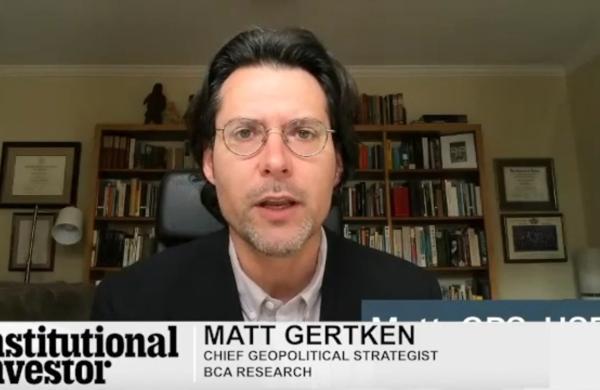A new year is a new chance to look back at what’s transpired and draw up a forecast for what’s ahead. Indeed, we at BlackRock were recently invited to address a major wealth management group on the very topic of our ten investment themes for 2015. Whereas this is not an exercise we have typically done in the past, we found the process instructive, and we hope it is equally so for Global Market Thought Leaders’ readers.
1. Crises happen. Expect greater volatility. An age of seemingly endless policy stimulus can — almost — lead one to forget that economies and financial markets are cyclical. Since 1990, with remarkable consistency, we have witnessed a spike in market volatility roughly every four years. According to Bloomberg data, the average annual increase in the level of the Chicago Board Options Exchange Market Volatility index, or VIX, in 1990, 1994, 1998 and 2002 was 99 percent, as both positive market performance and negative catalysts forced recalibrations in risk perceptions. Monetary policy disrupted this pattern in 2006 — the Federal Reserve was too easy — and in 2008 the VIX spiked to record levels. Today global policy may keep crisis at bay for a while longer, but the cyclical nature of markets has not changed. Thus we think investors should prepare for a meaningful rise in market turmoil, particularly as political risks appear to be on the rise. In fact, with the degree of monetary policy distortions to markets today, we are concerned a future volatility spike could be quite intense, so investors should remain wary.
2. Fundamentals matter, but three factors form the cornerstone of stability. Within the context of rising volatility, it is vital to properly appreciate economic and financial fundamentals, but some concepts are more central than others. In debt markets today, it is the leverage, liquidity and cash flow of the instruments in which one invests that matter the most. As market distortions normalize in the U.S. and economic and policy divergence takes hold around the world, we believe there is likely to be plenty of opportunity to witness the proverbial tide going out. Those investors not focused on these key factors are likely to get punished.
3. U.S. long-end rates are distorted but range-bound. For some time, we have argued that the long end of the yield curve has been distorted by monetary policy action in the U.S. but that it would remain better bid and capped, whereas short-end rates would be the site of pain. That view proved correct in 2014, and we think it still holds. And though we believe that fair value on ten-year Treasuries is probably close to 3 percent, we believe that yield should remain in the broad range of 1.5 to 2.5 percent for the year, with calls for it to veer much higher or lower improbable. In fact, relative to its developed-markets peers, the U.S. appears quite favorable in its fundamentals, and the U.S. dollar is likely to remain strong, putting Treasuries in a worthwhile position of positive carry, even at low absolute levels.
4. Inflation remains muted. A stronger dollar, declining commodity prices and disinflation stemming from technological innovation will combine to mute inflation in the U.S. and keep it dangerously low in Europe and Japan. Indeed, the euro zone’s flash consumer price index reading for December entered negative territory for the first time since October 2009. Although deflation might be a bane of the euro zone and Japan, we think it will help allow U.S. long-end rates to hang in well. Low inflation should also hold positive implications for low-income consumers.
5. U.S. long-end municipals also appear attractive. The long end of the U.S. muni market also exhibits the same positive criteria of its Treasury counterpart, and as the yield curve continues to flatten and economic fundamentals improve, long-end munis should continue to perform well.
6. The euro zone looks precarious. The fundamental picture in the euro zone appears quite dangerous to us, as the burden of economic recovery rests squarely on the European Central Bank, which, in its suggestion that a significant quantitative easing program may be on the way, has taken a page from Japan’s playbook. Yet rate levels are already highly distorted in the region, monetary policy appears incapable of hitting its inflation target, and the euro is likely headed even lower against the dollar. Whereas owning some European peripheral debt — and, selectively, bank paper — still makes sense, caution is warranted, as divergent and excessive monetary policy may be the foundation for greater market volatility going forward.
7. Japan may be living on borrowed time. Japan’s economy faces even greater struggles, as leverage is clearly far too high relative to cash flow. Our friends at economics market research group Cornerstone Macro in New York have recently argued that the weaker yen resulting from Abenomics has combined with serious demographic challenges to drive the household savings rate into negative territory. That in turn leaves the Bank of Japan as one of the only significant purchasers of Japanese government bonds, which raises the specter of policy risk and potential crisis. We think meaningful political and policy coordination may keep this from becoming a 2015 issue. Thus short-term investments in Japanese equities, although being short the yen, still may make sense. Yet long-term structural problems are very concerning.
8. Emerging markets can offer opportunity — and historic divergence. It is clear that certain commodities-dependent emerging markets, such as Russia, are likely to suffer greatly this year. This market segment is not the disaster that some have made it out to be, however. Leverage and liquidity in economies such as India, Mexico and Indonesia are better than many may think. And even as economic growth rates slow in some of these areas, relatively healthy sovereign balance sheets should help cushion the blow. As a result, we think emerging-markets debt is likely to be a good place to differentiate portfolios in 2015.
9. “It’s different this time.” These can be dangerous words, but not always wrong. The last major boost in U.S. household debt levels came after 2000 and was centered on real estate markets. Apart from a rise in student loan indebtedness, however, the consumer looks much healthier today. Instead, in this cycle it is the corporate sector — and, of course, governments — that is adding debt, but it has done so at historically low rates and, in many cases, to term-out existing leverage. The point is that credit cycles do differ in their details. That matters to fixed-income fundamental and technical investment conditions.
10. After a rough start, don’t count out equities. After the S&P 500’s 16 percent gain in 2012 and a 32 percent rise in 2013, many market pundits were expecting U.S. equity markets to stumble in 2014, particularly as January performance faltered. The index gained nearly 14 percent last year. These heady gains are unlikely in the year ahead, although we do believe a gain of nearly 10 percent for U.S. equities is quite possible. Overall, corporate capital expenditures are likely to be solid, the low cost of corporate financing continues to be a positive that is underappreciated by the market, and whereas valuations are certainly not cheap, they are not as overvalued as some suggest. Still, the risks of higher volatility have increased. This makes a portfolio-risk barbell most sensible. Take risks that have tangible upside potential, but such positions should be balanced with significant levels of liquid assets that meet the test of displaying strong leverage, liquidity and cash flow. We look forward to continuing this conversation as the year progresses.
Rick Rieder, managing director, is chief investment officer of fundamental fixed income and co-head of Americas fixed income for BlackRock in New York.
Get more on macro.






